The average human being needs 7 to 9 hours of sleep a night to function properly, but that’s not the case for all of our brethren out in the wild. Sleep offers a way to recuperate from the day and rebuild the energy that creatures spend their waking days exhausting, but it also offers a way to conserve energy. In extreme cases, hibernation allows animals to store up food and conserve it for months at a time.
The torpor of hibernation is fundamentally different from traditional sleep, and that excludes creatures like many species of bear from our list. Instead, the sleepiest animals in the world can be ranked by how many hours they’ll sleep in an average day. These lazy animals might make you feel better about yourself and remind you that it’s okay to get a full night’s sleep.
#10 Animal That Sleeps A Lot: Koala — 18 to 22 Hours of Sleep a Day
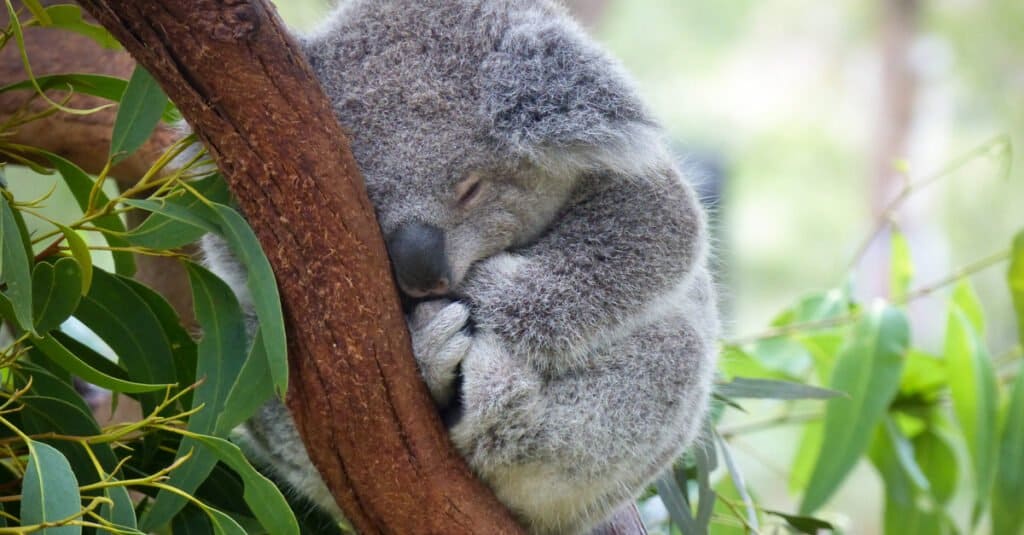
Koalas are mostly nocturnal, sleeping long hours to give their bodies the time and energy to digest food.
©Richard A Wall/Shutterstock.com
Australia’s adorable tree-climbing marsupials can blame a poor diet for their chronic case of sleepiness. The high branches of trees offer koalas protection from predators and a practically endless supply of eucalyptus leaves — but part of the reason there’s so little competition is that these leaves contain almost no nutritional value. But during the four to five hours that koala bears are awake, they’re absolutely voracious. Not only are they capable of eating an entire kilogram of eucalyptus leaves in a day, but they also store leaves inside their cheeks so they can snack mid-nap.
You can read more about the koala, Australia’s cuddliest and laziest marsupial, here.
#9Animal That Sleeps A Lot: Sloth — 10 to 20 Hours of Sleep a Day
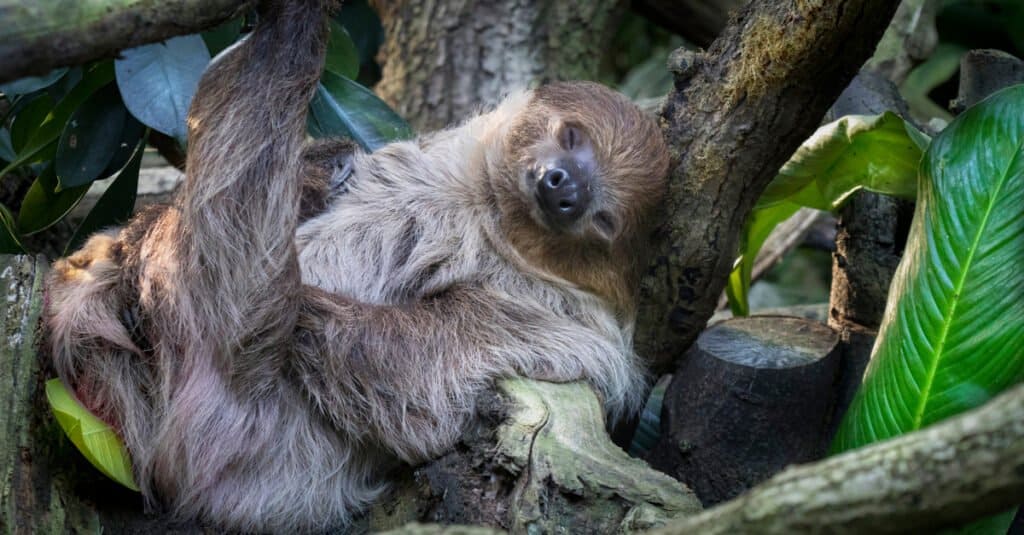
Captive sloths typically sleep much longer than wild sloths, who typically do not rest for more than 10 hours.
©milan noga/Shutterstock.com
Sloths are creatures synonymous with laziness in the popular imagination, and there’s a lot of truth to the claim. But while sloths in captivity have been witnessed sleeping up to 20 hours a day, research shows sloths in the wild sleeping for 10 hours a night or less. Part of the perception that the sloth is lazy comes down to this adorable critter’s habits. Their unique bodies allow them to dangle from tree branches, and they end up doing most of their activities while hanging — that includes giving birth and even mating in addition to sleeping and eating.
With food readily available and predators largely absent, sloths rarely even have a reason to leave their canopies.
Sloths may sleep less than you think, but it’s not the only unexpected fact about their lives. You can learn more about them here.
#8Animal That Sleeps A Lot: Little Brown Bat — Up to 20 Hours of Sleep a Day

Little Brown Bats sleep for an average of 20 hours per day to conserve energy.
©Ondrej Prosicky/Shutterstock.com
Bats are nocturnal, so it’s unlikely that you’ll see them awake during the day. But the fact of the matter is that they aren’t that much more alert after night falls. The little brown bat actively hunts for a few hours after dusk, but then it typically retreats back to its roost to return to its slumber. They’re fortunate to get that much energy.
The typical little brown bat needs to eat half their body weight each night to stay properly nourished, and mothers can end up eating more than their entire body weight during the period of a single night’s hunt. As a result, these bats don’t just sleep for most of the day. They also hibernate through the length of the winter.
Little brown bats play an important role in maintaining insect populations, and you can learn plenty more about them here.
#7Animal That Sleeps A Lot: Giant Armadillo — 16 to 18 Hours of Sleep a Day

During the mornings and evenings, giant armadillos forage for food, then sleep the rest of the day away.
©Heiko Kiera/Shutterstock.com
The carapace that giant armadillos come rolled up in can protect them from a lot of natural threats, but they still prefer to spend most of their time in hiding despite that extra layer of armor. Instead, these solitary creatures will create burrows where they’ll hide for 16 to 18 hours at a time. Researchers don’t technically know how much of that time is spent sleeping, as it’s believed that giant armadillos spend a significant amount of time in their burrows feeding as well. The close proximity of insects and larva means it’s often easy for a giant armadillo to get breakfast in bed.
The giant armadillo is built like a tank, but you can discover more about what goes on beneath the surface of that armor here.
#6Animal That Sleeps A Lot: North American Opossum — 18 Hours
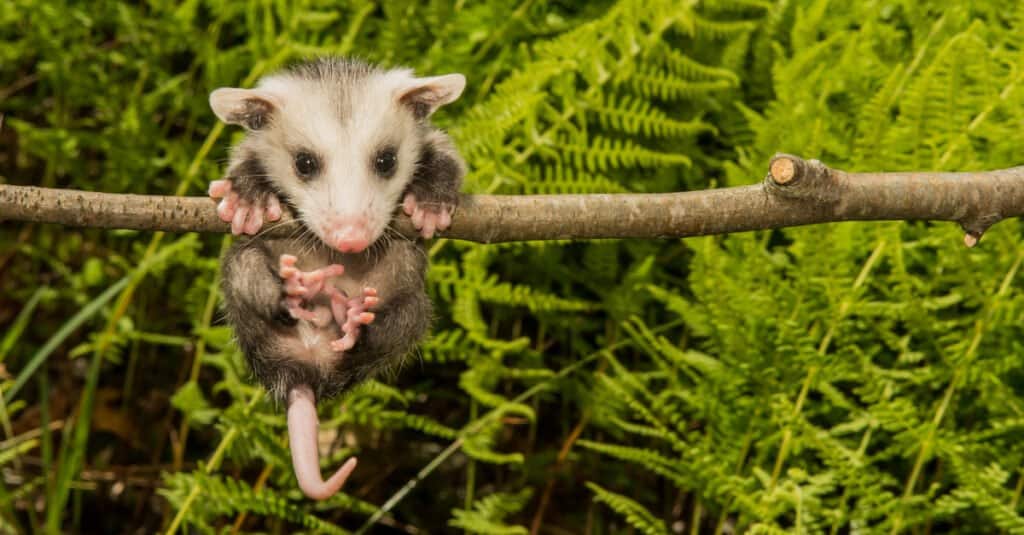
Opossums often sleep during the day in an abandoned burrow or hollow tree.
©Jay Ondreicka/Shutterstock.com
Opossums‘ unusual defense mechanism has made the phrase “playing possum” synonymous with pretending to be dead — but there’s a good chance that the prone opossum you see in your neighborhood is really fast asleep. But one myth that needs to be debunked is the notion that opossums sleep while hanging from their tails. Instead, opossums are nocturnal creatures that retreat to hollowed trunks or abandoned rodent nests when they’re done hunting.
The opossum is the only marsupial endemic to North America, and you can learn more about these fascinating creatures here.
#5Animal That Sleeps A Lot: Python — 18 Hours
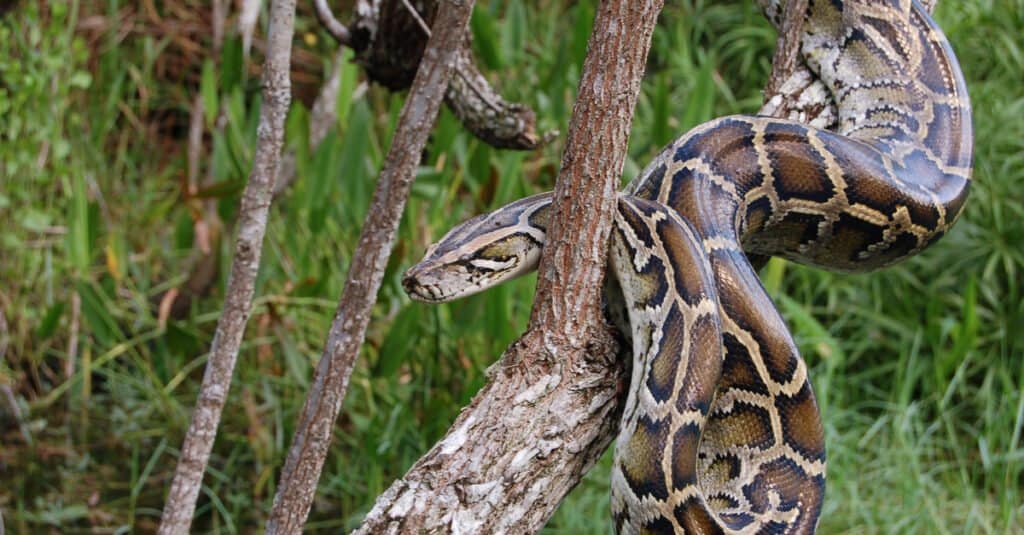
Since pythons do not close their eyes while sleeping, it is difficult to assess whether or not the snake is awake at any given moment.
©Heiko Kiera/Shutterstock.com
There’s still a lot that scientists don’t know about the sleep cycle of snakes, including whether or not they dream. The fact that they don’t close their eyes to go to sleep makes it difficult to study their behavior, and snakes also employ another method of resting called brumation that’s similar to the hibernation cycle of some mammals.
Among the laziest of snakes is the python, which is believed to sleep for up to 18 hours at a time. As nocturnal creatures, they do their hunting at night and then retreat to somewhere safe to rest without being threatened by predators. The down time comes in handy. Depending on the size of their prey, pythons can spend multiple days (or even weeks!) digesting a meal.
The python is one of the world’s most fascinating snakes, and you can dig deeper into their habits here.
#4Animal That Sleeps A Lot: Night Monkey — 17 Hours

Being nocturnal allows the night monkey to feed at night when bigger and more dominant monkeys are asleep.
©Korovko Gleb/Shutterstock.com
The fact that night monkeys only come out under the cover of darkness and spend most of their time in the dense tropical rainforests of Central America means that experts didn’t notice their population decline as quickly as they might otherwise. Their shortened activity cycles have a big part to do with their physiology. Their exceptional night vision lets them excel at hunting and survival in the dark, but it proves a liability in the daylight.
Night monkeys are also commonly known as owl monkeys thanks to their unique features. Even without daytime illumination, these primates are known for their agility. After resting up all day, night monkeys are able to navigate the rainforest high and low with great speed, despite the darkness.
Monkeys and primates, in general, all tend to sleep significantly more than humans, but you can learn about even more differences between us and our evolutionary cousins here.
#3Animal That Sleeps A Lot: Tiger — 16 Hours

After a
tiger eats
all of its prey, it goes to sleep. Once it awakens again, it begins searching for more food.
©Linda George/Shutterstock.com
In general, cats tend to be frequent sleepers, but tigers are the king of felines in terms of sleeping. Tigers are incredibly ferocious predators, but their muscular bodies need to produce a lot of energy. Combine this with the fact that they’re solitary predators, and a single failed night of hunting can lead to a vicious cycle of hunger and failure.
Tigers do most of their hunting at night — and while they spend a good 16 hours a day sleeping, they can spend up to 20 just lounging around. For the tiger, it’s all about being as efficient as possible with their limited energy.
The tiger is the world’s third-largest land carnivore, but there are plenty of other interesting facts about this wild cat here.
#2Animal That Sleeps A Lot: Tree Shrew — 16 Hours
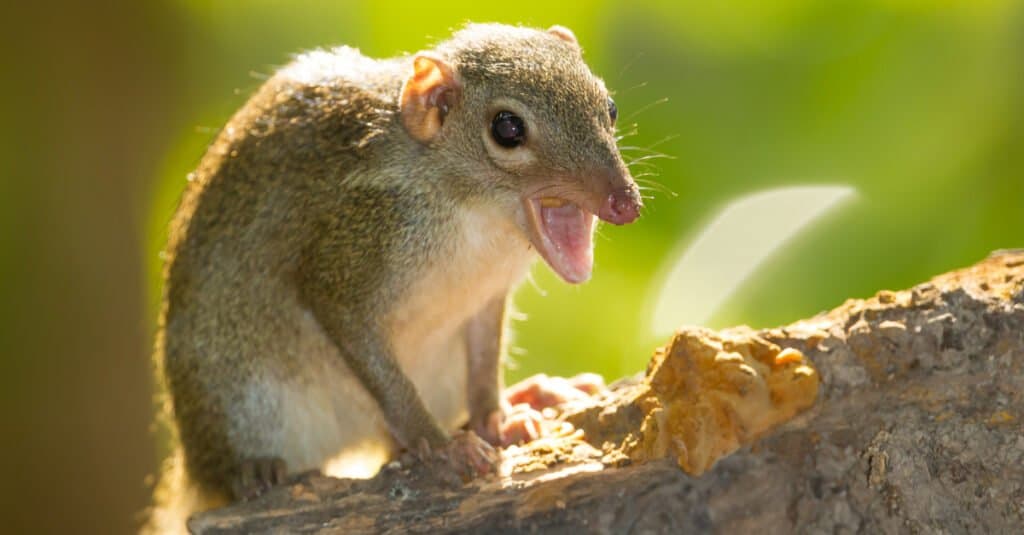
Did you know that tree shrews have similar sleep cycles to humans?
©kajornyot wildlife photography/Shutterstock.com
Thanks to their effective use as test subjects, scientists have significant data on the sleep process of rodents — but the tree shrew stands out as an aberration even by the standards they recognize. Tree shrews never seem to leave their nests at night, in part because the very structure of their eyes doesn’t accommodate visibility during the day.
In the wild, Tree Shrews eat insects mainly beetles and fruit. At most Zoos, northern tree shrews are fed chopped up greens, grapes, oranges, apples, root vegetables, mealworms, and crickets. These interesting, sleepy rodents are much smarter than the average rodent.
In fact, the most fascinating find when studying these creatures slumbering is that the rhythms of their sleep cycles more closely resemble humans than they do other rodents. It also seems to suggest that these longer sleep cycles allow for more meticulous memory formation.
#1Animal That Sleeps A Lot: Squirrel — 15 Hours
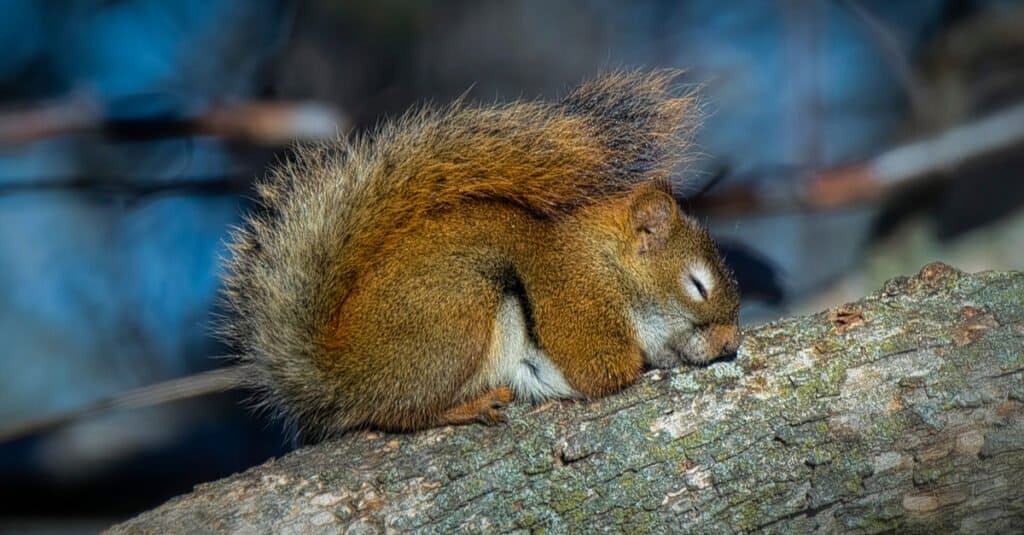
Squirrels spend up to 60% of their day asleep.
©Fiona M. Donnelly/Shutterstock.com
It’s commonly known that squirrels gather up supplies so that they can hunker down and hibernate through the winter, but they still sleep a whole lot even when they aren’t in their hibernation cycle.
Squirrels are active during the day and hunker down during the evening, but they also tend to sleep up to 15 hours a day during their active seasons. They’re even known to decorate their nests for their hibernation period — a period during which the squirrel is only awake 12 to 20 hours in an entire week.
Squirrels are one of the most prevalent species in the world, and you can discover more about their habits here.
Next Up: Discover 15 Amazing Animals that Eat Insects
Summary
Here is our collection of some of the longest-dozing creatures on the planet.
| Number | Animal That Sleeps A Lot |
| 1 | Squirrel |
| 2 | Tree Shrew |
| 3 | Tiger |
| 4 | Night Monkey |
| 5 | Python |
| 6 | North American Opossum |
| 7 | Giant Armadillo |
| 8 | Little Brown Bat |
| 9 | Sloth |
| 10 | Koala |
Up Next…
Now that you know the scoop on the sleepiest animals, read on to discover more wild facts about these amazing animal categories:
- Discover The Top Ten Animals With the Toughest Skin – From sun-shielding hippopotamus hide to the bony armor of an armadillo, discover these ten animals with skin that can withstand a lot of punishment.
- Discover The Top Nine Animals With The Shortest Lifespan – Catch them while you can! These nine creatures live out their days quickly, like the Labord’s chameleon that only lives one year and the dragonfly that makes it only four months!
- Discover 10 Animals That Reproduce Asexually – No mate required for Komodo dragons, aphids, marble crayfish and more who are able to reproduce all on their own!
The photo featured at the top of this post is © myphotobank.com.au/Shutterstock.com
Thank you for reading! Have some feedback for us? Contact the AZ Animals editorial team.







